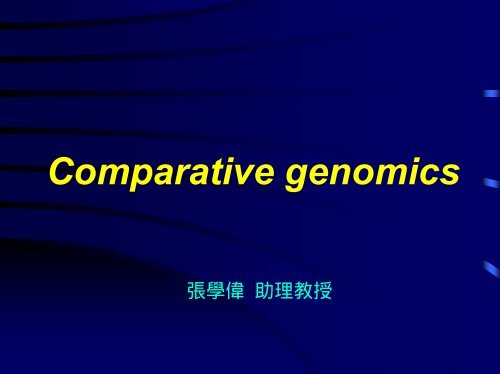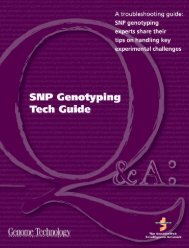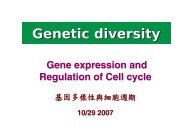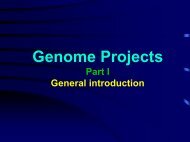Comparative genomics
Comparative genomics
Comparative genomics
You also want an ePaper? Increase the reach of your titles
YUMPU automatically turns print PDFs into web optimized ePapers that Google loves.
<strong>Comparative</strong> <strong>genomics</strong>
Definition:<br />
<strong>Comparative</strong> <strong>genomics</strong> is the study of the<br />
differences and similarities in genome structure<br />
and organization in different organisms.
Molecular evolution
Minimal genome concept
Force acting on evolution<br />
of genome size, some<br />
having additive effects.
A mosaic organization of the<br />
human genome at the<br />
nucleotide level.
In general, two classes of functional regions can be identified:<br />
Slowly evolving regions & fast-evolving regions.
On average, the mitochondrial genome evolves faster<br />
than the nuclear genome, but the fold difference is<br />
region-specific.
The rate variation observed did not exceed 1.8-fold between<br />
the fastest and the slowest order, thus supporting the suitability<br />
of mtDNA for drawing mammalian phylogeny.
# of gene & # of protein cannot match<br />
1. Alternative splicing increases proteome complexity incredibly<br />
2. Posttranscriptional editing.
Molecular phylogeny
The molecular clock concept postulates that biological molecules<br />
evolve , within statistical fluctuations, at a rather constant rate,<br />
thus allowing a measure of their genetic distances based on the<br />
divergence time between two marker generally inferred form other,<br />
Nonmolecular sources.
The composition of archaeal genome
In 1969, R.H Whittaker<br />
The five-kingdom system prevailed in biology for over 20Yr.<br />
Fig. 26.15
Fig. 26.16<br />
• Many microbiologists have divided the two<br />
prokaryotic domains into multiple kingdoms (based<br />
on cladistic analysis of molecular data.)<br />
– Keep in mind that phylogenetic trees and<br />
taxonomic groupings are hypotheses that fit<br />
the best available data.
– A domain is a taxonomic level about kingdom.<br />
• Current taxonomy recognizes two<br />
prokaryotic domains: domain Bacteria and<br />
domain Archaea.<br />
• because they diverged so early in life and are so<br />
fundamentally different.<br />
– But they are structurally<br />
organized at the<br />
prokaryotic level.<br />
Fig. 27.2
Molecular phylogeny in the <strong>genomics</strong> era<br />
1. Orthologues<br />
2. Paralogues<br />
3. Non-orthologues gene displacements
1. Orthologues<br />
are homologous genes in different organisms that<br />
encode proteins with the same function.<br />
Evolved by direct vertical descent.<br />
Evolved simply by the gradual accumulation of<br />
mutations.
2. Paralogues<br />
are homologous genes<br />
within an organisms<br />
encoding proteins with<br />
related but non-identical<br />
functions.<br />
Arise by gene<br />
duplication followed by<br />
mutation accumulation.<br />
(protein superfamilies)
Similarity measure: orthology versus paralogy
3. Non-orthologues gene displacements<br />
Functional equivalent of proteins requires<br />
neither sequence similarity nor even common<br />
three-dimensinal folds.<br />
Rather common
Protein evolution by exon shuffling
The large number of transposable elements and<br />
repetitive sequences in introns will facilitate<br />
exon shuffling by promoting mismatching and<br />
recombination of non-homologous genes.
The smallest genome sequenced to date is 0.58Mb<br />
(M. genitalium)
As the size of the prokaryotic genome increase, then<br />
the number of paralogues will increase.
Although the genetic role of mtDNA appears to be universally<br />
conserved, this genome exhibits remarkable variation in<br />
conformation and size.
Although the genetic role of mtDNA appears to be<br />
universally conserved, this genome exhibits remarkable<br />
variation in actual gene content.
Although the genetic role of mtDNA appears to be universally<br />
conserved, this genome exhibits remarkable variation in<br />
arrangement and expression.
Many mitochondrial genomes<br />
lack a number of key genes.<br />
And missing genes are can be<br />
Found in the nucleus.<br />
Functional transfer of mitochondrial<br />
Genes to nucleus has stopped in<br />
Animals, hence their consistency<br />
in size.
Distribution of the molecular function of 26383 putative<br />
human genes.
Functions of 1523 putative orthogues common to<br />
human, fruit fly,nematode genomes.






